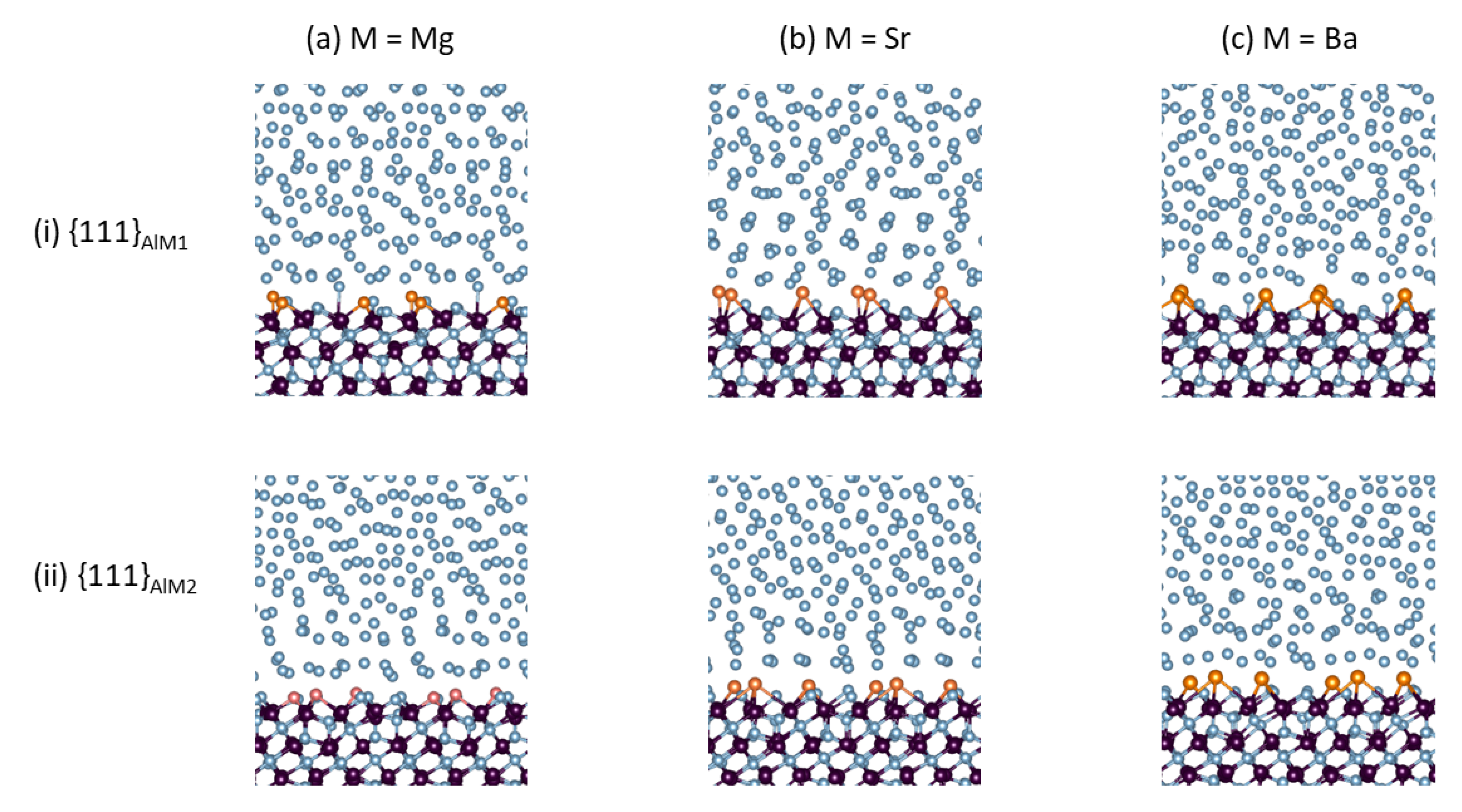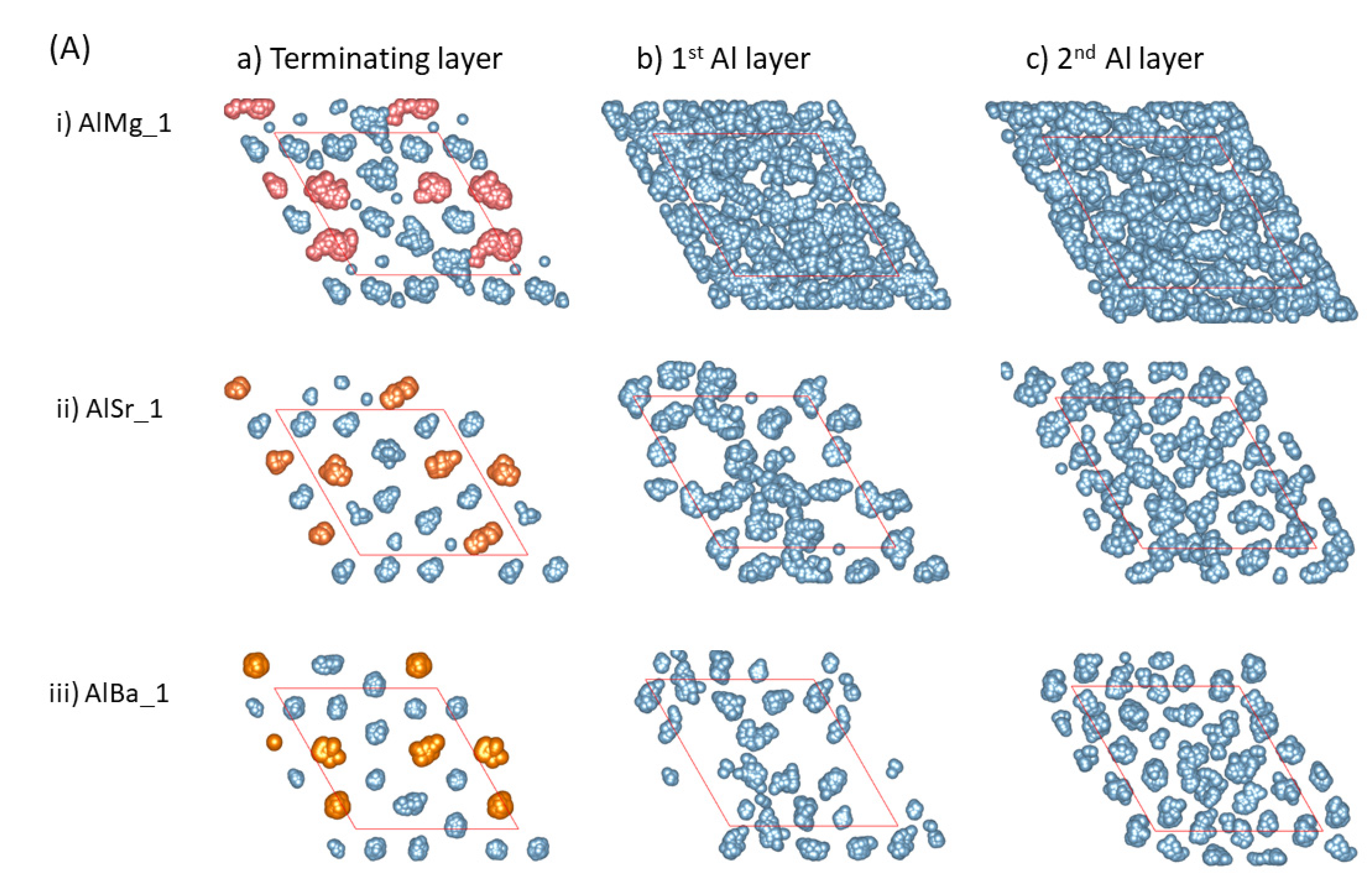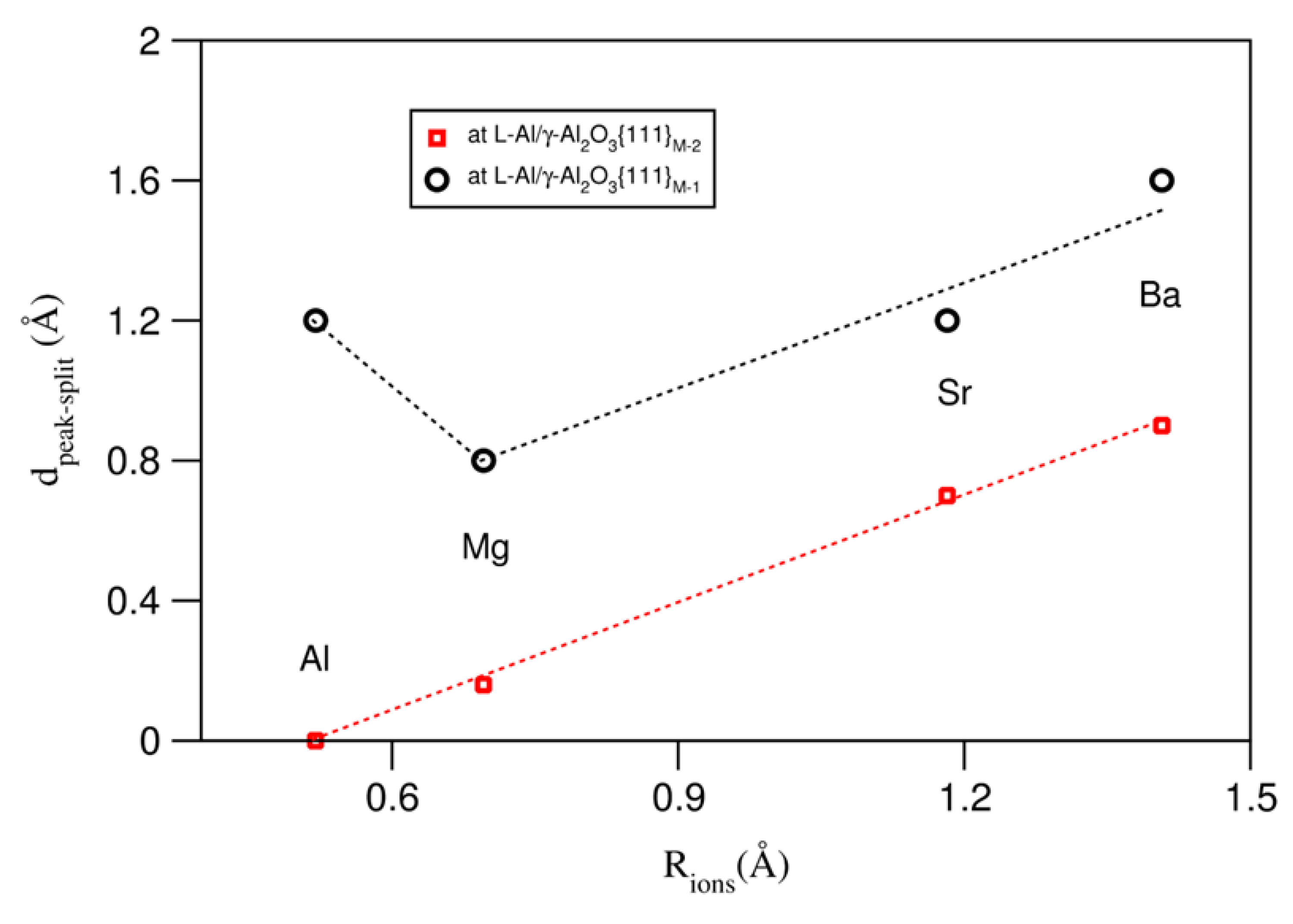Segregation of Alkaline Earth Atoms Affects Prenucleation at L-Al/γ-Alumina Interfaces
Abstract
:1. Introduction
2. Details of Methods
3. Results
- (1)
- The AE and Al atoms at the terminating layer show strong localized characteristics, as compared with those metal atoms at the pristine L-Al/γ-Al2O3{1 1 1} interfaces [16].
- (2)
- The localization content of the terminating atoms increases from Mg to Sr to Ba. Figure 3i shows that only the atoms at the terminating Al/Mg layer exhibit some localized character, while the Al atoms at the first layer display delocalized, liquid-like behavior. There are vacancies on top of Sr and Ba atoms at the first Al layer, and localization exists at the second Al layers (Figure 3Aii, Aiii, Bii and Biii). This phenomenon may relate to the atomic sizes.
- (3)
- Prenucleation is weak even at the first metal layer for the Mg-segregated interfaces. For the Sr- and Ba-segregated interfaces, there are vacancies at the first Al layer and it thus, is rough. This causes amorphous arrangements of the Al atoms at the second layers. Analysis showed no long-range ordering at the third layer (not shown here).
| Element | Elec. Config. | Χ | Formula of Oxides | d(M–O) (Å) |
|---|---|---|---|---|
| Al | [Ne] 3s2 3p1 | 1.61 | Al+2.022O−1.343 | 1.92 [53] |
| Mg | [Ne] 3s2 3p0 | 1.31 | Mg+1.66O−1.66 | 2.11 [53] |
| Sr | [Kr] 5s2 5p0 | 0.95 | Sr +1.35O−1.35 | 2.57 [54] |
| Ba | [Xe] 6s2 6p0 | 0.89 | Ba+1.36O−1.36 | 2.76 [54] |
4. Discussion
5. Summary
- (1)
- The AE-atom-segregated L-Al/γ-Al2O3{1 1 1} interfaces exhibit localized characteristics at the interfaces.
- (2)
- Chemically, the AE atoms are positively charged and bonded to the outmost O atoms.
- (3)
- The segregated AE atoms are positioned dominantly on O triangles of the γ-Al2O3{1 1 1} substrates, a condition which reconstructs atoms adjacent to the substrates and causes atomic roughness of the substrate surfaces.
- (4)
- The sizes of the AE ions significantly affect the atomic ordering at the interfaces.
- (5)
- Prenucleation at the two different authentic substrates causes them to become weakened and minimized to the same level.
- (6)
- The obtained information herein enriches our understanding of the effects of impurity segregation at liquid metal/solid interfaces, and further helps to manipulate heterogeneous nucleation via controlling impurity segregation.
Supplementary Materials
Author Contributions
Funding
Data Availability Statement
Acknowledgments
Conflicts of Interest
References
- Turnbull, D. Kinetics of heterogeneous nucleation. J. Chem. Phys. 1950, 18, 198–203. [Google Scholar] [CrossRef]
- Murty, B.S.; Kori, S.A.; Chakraborty, M. Grain refinement of aluminium and its alloys by heterogeneous nucleation and alloying. Intern. Mater. Rev. 2002, 47, 3–29. [Google Scholar] [CrossRef]
- Kelton, K.F.; Greer, A.L. Nucleation in Condensed Matter: Applications in Materials and Biology; Elsevier Science: Oxford, UK, 2010. [Google Scholar]
- Fan, Z.; Mendis, C. Heterogeneous nucleation, grain initiation and grain refinement of Mg-alloys. In Proceedings of the 11th International Conference on Magnesium Alloys and Their Applications, Beaumont Estate, Old Windsor, UK, 24–27 July 2018. [Google Scholar]
- Fan, Z.; Gao, F.; Jiang, B.; Que, Z.P. Impeding nucleation for more significant grain refinement. Sci. Rep. 2020, 10, 9448. [Google Scholar] [CrossRef] [PubMed]
- Cibula, A. The grain refinement of aluminium alloy castings by addition of titanium and boron. J. Inst. Met. 1951, 80, 1–16. [Google Scholar]
- Greer, A.L.; Bunn, A.M.; Tronche, A.; Evans, P.V.; Bristow, D.J. Modelling of inoculation of metallic melts: Application to grain refinement of aluminium by Al-Ti-B. Acta Mater. 2000, 48, 2823–2835. [Google Scholar] [CrossRef]
- Fan, Z.; Wang, Y.; Zhang, Y.; Qin, T.; Zhou, X.R.; Thompson, G.E.; Pennycook, T.; Hashimoto, T. Grain refining mechanism in the Al/Al–Ti–B system. Acta Mater. 2015, 84, 292–304. [Google Scholar] [CrossRef]
- Greer, A.L. Overview: Application of heterogeneous nucleation in grain-refining of metals. J. Chem. Phys. 2016, 145, 211704. [Google Scholar] [CrossRef]
- Impey, S.A.; Stephenson, D.J.; Nicholls, J.R. Mechanism of scale growth on liquid aluminium. J. Mater. Sci. Technol. 1988, 4, 1126–1132. [Google Scholar] [CrossRef]
- Wang, Y.; Li, H.-T.; Fan, Z. Oxidation of aluminium alloy melts and inoculation by oxide particles. Trans. Indian Inst. Met. 2012, 65, 653–661. [Google Scholar] [CrossRef]
- Kim, K. Formation of endogenous MgO and MgAl2O4 particles and their possibility of acting as substrate for heterogeneous nucleation of aluminum grains. Surf. Interface Anal. 2015, 47, 429–438. [Google Scholar] [CrossRef] [Green Version]
- Fan, Z.; Wang, Y.; Xia, M.; Arumuganathar, S. Enhanced heterogeneous nucleation in AZ91D alloy by intensive melt shearing. Acta Mater. 2009, 57, 4891–4901. [Google Scholar] [CrossRef]
- Verwey, E.J.W. The crystal structure of γ-Fe2O3 and γ-Al2O3. Z. Kristallogr. 1935, 91, 65–69. [Google Scholar] [CrossRef]
- Smrčok, L.; Langer, L.; Krestan, J. γ-Alumina: A single crystal X-ran diffraction study. Acta Cryst. C 2006, 62, i83–i84. [Google Scholar] [CrossRef] [PubMed]
- Fang, C.M.; Yasmin, S.; Fan, Z. Interfacial interaction and prenucleation at liquid-Al/γ-Al2O3{1 1 1} interfaces from ab initio molecular dynamics simulations. J. Phys. Commun. 2021, 5, 015007. [Google Scholar] [CrossRef]
- Fan, Z. An epitaxial model for heterogeneous nucleation on potent substrates. Metall. Mater. Trans. A 2013, 44, 1409–1418. [Google Scholar] [CrossRef] [Green Version]
- Men, H.; Fan, Z. Prenucleation induced by crystalline substrates. Metall. Mater. Trans. A 2018, 49, 2766–2777. [Google Scholar] [CrossRef]
- Men, H.; Fan, Z. Prenucleation at the liquid/substrate interfaces: An overview. Metals 2022, 12, 1704. [Google Scholar] [CrossRef]
- Fang, C.M.; Men, H.; Fan, Z. Effect of substrate chemistry on prenucleation. Metall. Mater. Trans. A 2018, 49, 6231–6242. [Google Scholar] [CrossRef] [Green Version]
- Bunn, A.M.; Schumacher, P.; Kearns, M.A.; Boothroy, C.B.; Greer, A.L. Grain refinement by Al-Ti-B alloys in aluminium melts: A study of the mechanisms of poisoning by zirconium. Mater. Sci. Technol. 1999, 15, 1115–1123. [Google Scholar] [CrossRef]
- Wang, Y.; Fang, C.M.; Zhou, L.; Hashimoto, T.; Zhou, X.; Ramasse, Q.M.; Fan, Z. Mechanism for Zr poisoning of Al-Ti-B based grain refiners. Acta Mater. 2019, 164, 428–439. [Google Scholar] [CrossRef] [Green Version]
- Wang, Y.; Que, Z.P.; Hashimoto, T.; Zhou, X.R.; Fan, Z. Mechanism for Si poisoning of Al-Ti-B grain refiners in Al alloys. Metal. Mater. Trans. A 2020, 51, 5743–5757. [Google Scholar] [CrossRef]
- Wang, S.H.; Wang, Y.; Ramasse, Q.; Fan, Z. The nature of native MgO in Mg and its alloys. Metal. Mater. Trans. A 2020, 51, 2957–2974. [Google Scholar] [CrossRef] [Green Version]
- Ma, S.D.; Dong, Z.D.; Zong, Z.F.; Jing, T.; Dong, H.B. Solute-adsorption enhanced heterogeneous nucleation: The effect of Cu adsorption on α-Al at the sapphire substrate. Phys. Chem. Chem. Phys. 2021, 23, 5270–5282. [Google Scholar] [CrossRef] [PubMed]
- Wang, Y.; Wang, S.H.; Fang, C.M.; Que, Z.P.; Hashimoto, T.; Zhou, X.R.; Ramasse, Q.M.; Fan, Z. Manipulating nucleation potency of substrates by interfacial segregation. Metals 2022, 12, 1636. [Google Scholar] [CrossRef]
- Ma, S.D.; Yan, R.; Zong, N.F.; Davidchack, R.L.; Jing, T.; Dong, H.B. Unveiling the influence of interfacial bonding and dynamics on solid/liquid interfacial structures: An ab initio molecular dynamics study of (0001) sapphire-liquid Al interfaces. Phys. Rev. Mater. 2020, 4, 023401. [Google Scholar] [CrossRef]
- Zhang, G.C.; Hu, T.; Shuai, S.S.; Chen, C.Y.; Xu, S.Z.; Yu, J.B.; Ren, W.; Wang, J.; Ren, Z.M. Ab-initio molecular dynamics study of heterogeneous nucleation at the liquid-Y/α-Al2O3 interface. Comput. Mater. Sci. 2023, 217, 111899. [Google Scholar] [CrossRef]
- Shen, G.; Lyu, X.M.; Zhao, S.Y.; You, C.; Wang, X.W.; Chen, M.F. The first-principles research of Cao and MgO particulate heterogeneous nucleation in Mg alloys. Appl. Surf. Sci. 2022, 593, 153224. [Google Scholar] [CrossRef]
- Fang, C.M.; Fan, Z. Effects of Segregation of Sc, Y and La Atoms on Prenucleation at the Interfaces between Liquid-Al and γ-Al2O3{1 1 1}. Metals 2022, 12, 1550. [Google Scholar] [CrossRef]
- Kang, J.; Zhu, J.; Curtis, C.; Blake, D.; Glatzmaier, G.; Kim, Y.-H.; Wei, S.-H. Atomically abrupt liquid-oxide interface stabilized by self-regulated interfacial defects: The case of Al/Al2O3 interfaces. Phys. Rev. Lett. 2012, 108, 226105. [Google Scholar] [CrossRef] [Green Version]
- Yan, R.; Sun, W.Z.; Ma, S.D.; Jing, T.H.B.; Dong, H.B. The orientation dependence of liquid ordering at α-Al2O3/Al solid-liquid interfaces: A molecular dynamics study. Comput. Mater. Sci. 2020, 174, 109489. [Google Scholar] [CrossRef]
- Fang, C.M.; Fan, Z. Prenucleation at the liquid-Al/α-Al2O3 and the liquid-Al/MgO interfaces. Comput. Mater. Sci. 2020, 171, 109258. [Google Scholar] [CrossRef]
- Oh, S.H.; Kauffmann, Y.; Scheu, C.; Kaplan, W.D.; Rühle, N. Ordered liquid aluminium at the sapphire. Science 2005, 310, 661–663. [Google Scholar] [CrossRef] [PubMed] [Green Version]
- Kauffmann, Y.; Oh, S.H.; Koch, C.T.; Hashibon, A.; Scheu, C.; Rühle, M.; Kaplan, W.D. Quantitative analysis of layering and in-plane ordering structural ordering at an alumina-aluminum solid liquid interface. Acta Mater. 2011, 59, 4378–4386. [Google Scholar] [CrossRef]
- Curiotto, S.; Chien, H.; Meltzman, H.; Wynblatt, P.; Rohrer, G.S.; Kaplan, W.D.; Chatain, D. Orientation relationships of copper crystals on cplane sapphire. Acta Mater. 2011, 59, 5320–5331. [Google Scholar] [CrossRef]
- Fang, C.M.; Fan, Z. Prenucleation at the interface between MgO and liquid magnesium: An ab initio molecular dynamics study. Metal. Mater. Trans. A 2020, 51, 788–797. [Google Scholar] [CrossRef] [Green Version]
- Fang, C.M.; Fan, Z. Atomic ordering at the Liquid-Al/MgAl2O4{1 1 1} Interfaces: Ab initio molecular dynamics simulations. Metal. Mater. Trans. A 2020, 51, 6318–6326. [Google Scholar] [CrossRef]
- Kresse, G.; Furthmüller, J. Efficiency of ab-initio total energy calculations for metals and semiconductors using a plane-wave basis set. Comput. Mater. Sci. 1996, 6, 15–50. [Google Scholar] [CrossRef]
- Blöchl, P.E. Projector augmented-wave method. Phys. Rev. B 1994, 50, 17953–17978. [Google Scholar] [CrossRef] [Green Version]
- Perdew, J.P.; Burke, K.; Ernzerhof, M. Generalized gradient approximation made simple. Phys. Rev. Lett. 1996, 77, 3865–3868. [Google Scholar] [CrossRef] [PubMed] [Green Version]
- Monkhorst, H.J.; Pack, J.D. Special points for Brillouin-zone integrations. Phys. Rev. B 1976, 13, 5188–5192. [Google Scholar] [CrossRef]
- Brostow, W.; Hagg-Lodbland, H.E. Materials: Introduction and Applications; John Wiley & Sons: Hoboken, NJ, USA, 2017. [Google Scholar]
- Hashibon, A.; Adler, J.; Finnis, M.W.; Kaplan, W.D. Atomistic study of structural correlations at a liquid-solid interface. Comput. Mater. Sci. 2002, 24, 443–452. [Google Scholar] [CrossRef] [Green Version]
- Wearing, D.; Horsfield, A.P.; Xu, W.W.; Lee, P.D. Which wets TiB2 inoculant particles: Al or Al3Ti? J. Alloys Compd. 2016, 664, 460–468. [Google Scholar] [CrossRef] [Green Version]
- Wang, J.S.; Horsfield, A.P.; Schwingenschlögl, U.; Lee, P.D. Heterogeneous nucleation of solid Al from the melt by TiB2 and Al3Ti: An ab initio molecular dynamics study. Phys. Rev. B 2010, 82, 184203. [Google Scholar] [CrossRef] [Green Version]
- Fang, P.X.W.; Nihtianov, S.; Sberma, P.; Fang, C.M. Interfaces between crystalline Si and amorphous B: Interfacial interactions and change barriers. Phys. Rev. B 2021, 103, 075301. [Google Scholar] [CrossRef]
- Bader, R.F.W. A quantum-theory of molecular-structure and its applications. Chem. Rev. 1991, 91, 893–928. [Google Scholar] [CrossRef]
- Bader, R.F.W. A bonded path: A universal indicator of bonded interactions. J. Phys. Chem. A 1998, 102, 7314–7323. [Google Scholar] [CrossRef]
- Henkelman, G.; Arnaldsson, A.; Jónsson, H. A fast and robust algorithm for Bader decomposition of charge density. Comput. Mater. Sci. 2006, 36, 254–360. [Google Scholar] [CrossRef]
- Pauling, L. The nature of the chemical bond. Application of results obtained from the quantum mechanics and from a theory of paramagnetic susceptibility to the structure of molecules. J. Am. Chem. Soc. 1931, 53, 1367–1400. [Google Scholar] [CrossRef]
- Brown, I.D. Bond valence-a simple structural model for inorganic chemistry. Chem. Soc. Rev. 1978, 7, 359–376. [Google Scholar] [CrossRef]
- Fiquet, G.; Richet, P.; Montagnac, G. High-temperature thermal expansion of lime, periclase, corundum and spinel. Phys. Chem. Min. 1999, 17, 103–111. [Google Scholar] [CrossRef]
- Wyckoff, R.W.G. The Structure of Crystals, 2nd ed.; Reinhold Publishing Corporation: New York, NY, USA, 1935. [Google Scholar]
- Shannon, R.D. Revised effective ionic radii and systematic studies of interatomic distances in halides and chalcogenides. Acta Cryst. A 1976, 32, 751–767. [Google Scholar] [CrossRef]
- Brese, N.E.; O’Keeffe, M. Bond-valence parameters for solids. Acta Cryst. B 1991, 47, 192–197. [Google Scholar] [CrossRef]
- Bollada, P.C.; Men, M.; Fang, C.M.; Jimack, P.K.; Fan, Z.; Mullis, A.M. A novel route to the coupling of molecular dynamics and phase-field simulations of crystal growth. IOP Conf. Series 2019, 529, 012032. [Google Scholar] [CrossRef]
- Bollada, P.C.; Jimack, P.K.; Mullis, A.M. Towards a physically consistent phase-field model for alloy solidification. Metal 2022, 12, 272. [Google Scholar] [CrossRef]
- Singh, G.; Yu, Y.; Ernst, F.; Raj, R. Shear strength and sliding at a metal-ceramic (aluminium-spinel) interface at ambient and elevated temperatures. Acta Mater. 2007, 55, 3049–3057. [Google Scholar] [CrossRef]
- Karakozov, E.S.; Konyshov, G.; Musin, R.S. Fundamentals of welding metals to ceramic materials. J. Welding Intern. 1993, 7, 991–996. [Google Scholar] [CrossRef]







Disclaimer/Publisher’s Note: The statements, opinions and data contained in all publications are solely those of the individual author(s) and contributor(s) and not of MDPI and/or the editor(s). MDPI and/or the editor(s) disclaim responsibility for any injury to people or property resulting from any ideas, methods, instructions or products referred to in the content. |
© 2023 by the authors. Licensee MDPI, Basel, Switzerland. This article is an open access article distributed under the terms and conditions of the Creative Commons Attribution (CC BY) license (https://creativecommons.org/licenses/by/4.0/).
Share and Cite
Fang, C.; Fan, Z. Segregation of Alkaline Earth Atoms Affects Prenucleation at L-Al/γ-Alumina Interfaces. Metals 2023, 13, 761. https://doi.org/10.3390/met13040761
Fang C, Fan Z. Segregation of Alkaline Earth Atoms Affects Prenucleation at L-Al/γ-Alumina Interfaces. Metals. 2023; 13(4):761. https://doi.org/10.3390/met13040761
Chicago/Turabian StyleFang, Changming, and Zhongyun Fan. 2023. "Segregation of Alkaline Earth Atoms Affects Prenucleation at L-Al/γ-Alumina Interfaces" Metals 13, no. 4: 761. https://doi.org/10.3390/met13040761





